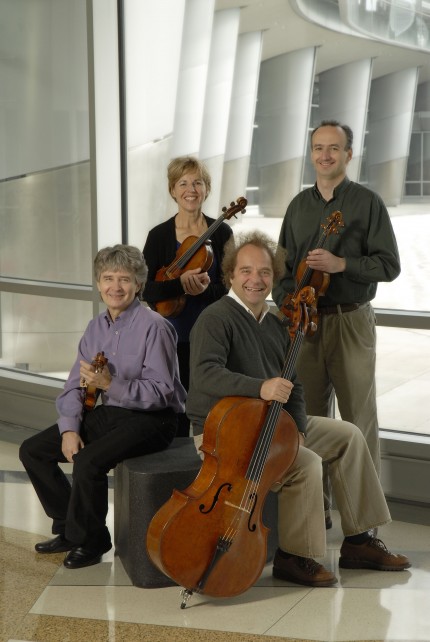Takács Quartet in tune with Janáček and Barber at Ravinia

The Takács String Quartet returned to the Ravinia Festival’s Martin Theatre Monday night for the fifth time, this time playing music of Janáček, Barber and Beethoven, and demonstrating that it remains one of the world’s premiere chamber ensembles.
The evening opened with Janáček’s String Quartet No. 2, subtitled “Intimate Letters,” in which the group effectively displayed their great versatility and effortless ensemble playing. Written in 1928, the work was inspired by the 74-year-old Janáček’s infatuation with the married Kamila Stossel, a woman less than half his age; it is littered with abrupt shifts in mood, tempo, and texture, all of which the Takács members navigated deftly.
In the episodic first movement, from the thunderous opening cello trill, eerie ponticello recitatives for the viola, and soaring lyrical lines above (or below) frenetic, driving accompaniment figures, each passage was imbued with its own idiosyncratic character. Particularly impressive was the quartet’s ability to “freeze” in the many grand-pauses that separate the different sections, seemingly suspending time and leaving the audience holding its collective breath. The lush viola solos of the second movement were delivered with robust, sonorous tone by Geraldine Walther, and the dance-like third movement, with its obsessive dotted-rhythm accompaniment, had an entrancing, distinctively Czech lilt. The finale was played in perhaps too genteel a fashion for the vigor of the music, but overall the performance effectively conveyed all the anxiety, passion, ardor, and, at times, ambivalence of an aging man desperately in love.
The Takács Quartet absolutely shone in the famous Adagio from Barber’s String Quartet in B Minor. From the opening bars, all of the players maintained seamless bow changes and limpid legato—if one closed one’s eyes it was often difficult to tell which instrument was playing which line. Most impressive was the pacing of the eight-minute work; starting quietly as though from afar, the musicians built gradually to the movement’s climax, rather than merely lingering in the beauty of the individual parts.
The late Beethoven quartets are works that sound as singular and strange today as when they were written. After the virtuosic ensemble playing of the first half, however, Beethoven’s String Quartet in A minor, Op. 132, was something of a letdown, especially considering the group’s reputation in this repertory.
After a brief sostenuto introduction, the first movement is wandering and motivic, and would have benefited from a more detailed approach, rather than just trusting that Beethoven’s genius would come through. The highlight of the quartet is its third movement, marked “Heiliger Dankegesang eines Genesenen an die Gottheit, in der lydischen Tonart” (“Hymn in thanksgiving to the divinity, of an invalid on his convalescence, in the Lydian mode”), written after Beethoven’s recovery from a serious illness. The playing, though, was far from intimate, with a forward, aggressive sound when more restrained dynamics might have drawn listeners in.
While the solemn moments were performed in perhaps too extroverted a fashion, the scherzando sections of the movement were breathless and thrilling. The Takács members played the final two movements with the reckless abandon and jarring dynamic shifts appropriate to the deaf Beethoven’s violent temper and mercurial moods.
The Takács Quartet performs 8:30 p.m. Wednesday at Ravinia’s Martin Theater in a program featuring Janáček’s String Quartet No. 1 (“The Kreuzer Sonata”), Smetana’s String Quartet No. 1 (“From My Life”) and Beethoven’s “Razumovsky” Quartet in E minor, Op.59, no.2. ravinia.org
Posted in Uncategorized




